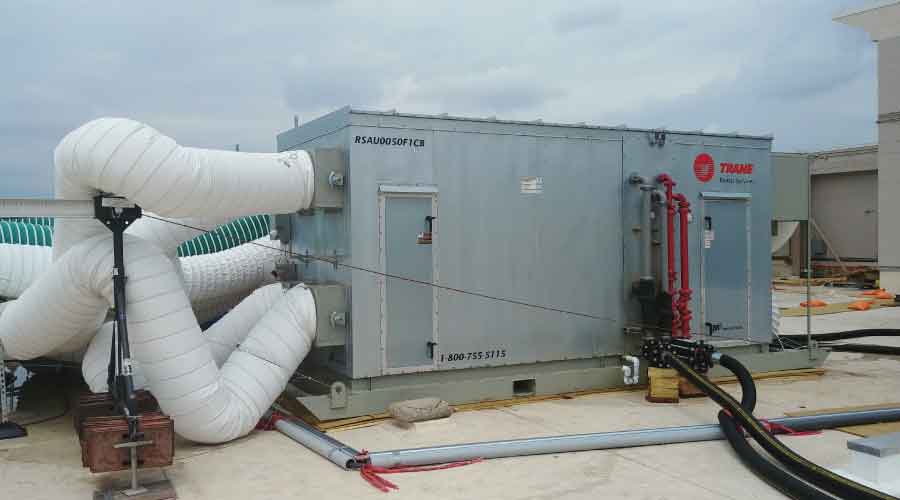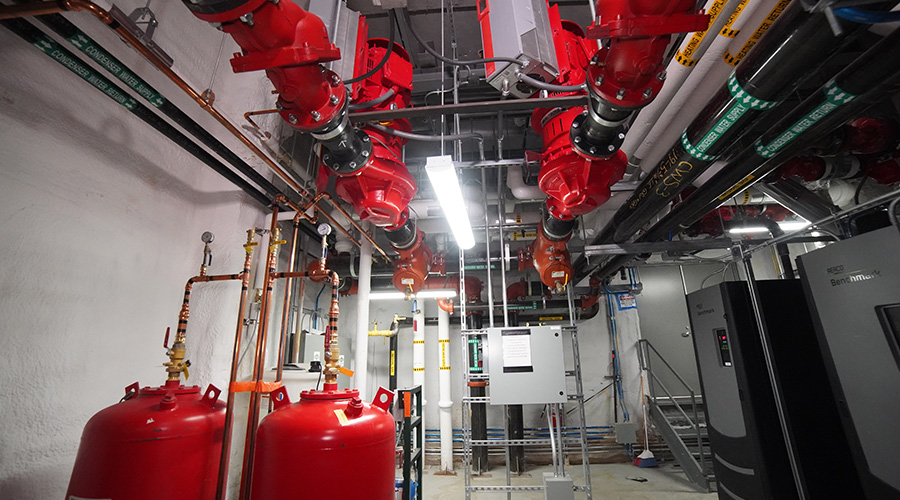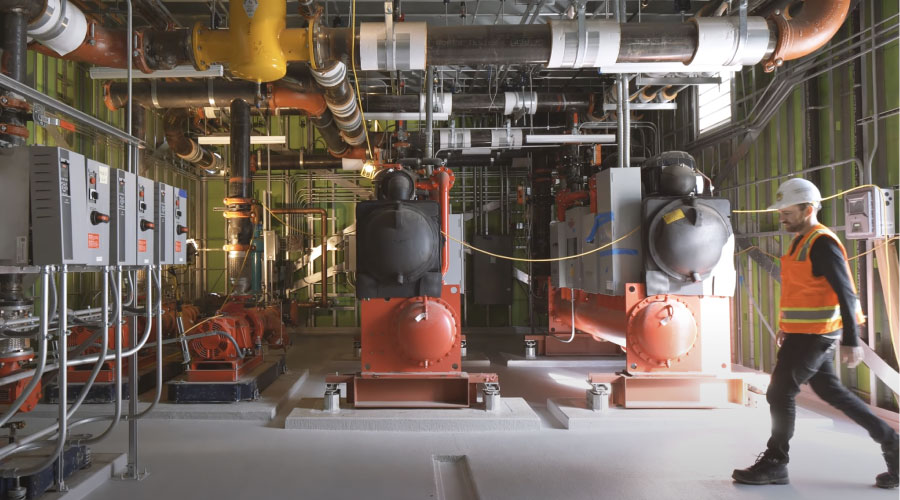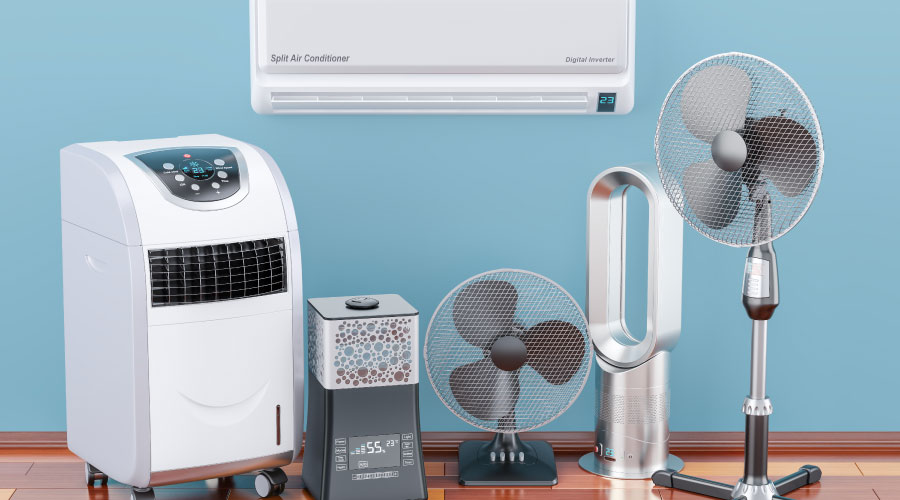 To ensure a successful rental experience, managers and designers needs to determine the required capacities of the temporary AHUs, including airflow, external static pressure, entering and leaving air conditions, and entering and leaving water temperatures.MC NH
To ensure a successful rental experience, managers and designers needs to determine the required capacities of the temporary AHUs, including airflow, external static pressure, entering and leaving air conditions, and entering and leaving water temperatures.MC NHWhich Portable Cooling Unit Is Right for Your Facilities?
The challenge for managers selecting temporary equipment is ensuring the product meets the facility's cooling needs.
By Dean Pfoltner, Parker Matthews
Many institutional and commercial facilities rely on portable cooling units to supplement and, in an emergency, fill in for central HVAC systems. The challenge for engineering and maintenance managers selecting this temporary equipment is ensuring the product — whether rented or purchased — meets the facility's cooling needs.
By understanding key features and functions in new-generation air-handling units (AHU) and spot coolers and assessing a facility’s evolving need for cooling, managers will be better able to successfully match available temporary equipment options to facility needs, whether in an emergency or a supplemental situation.
The need for temporary or emergency cooling in server rooms, gymnasiums or other critical areas in facilities might be a result of unexpected equipment failure or a scheduled equipment replacement. Temporary equipment can be provided for air-side and water-side equipment.
Air-side equipment includes temporary AHUs, temporary fans, and spot coolers. Water-side equipment includes chillers — water-cooled and air-cooled options are available — cooling towers, and hot water boilers. Several variables affect which type of equipment is needed, including the reason for the temporary equipment, the type of facility the equipment serves, and the equipment capabilities.
Spotlight on spot coolers
Spot coolers typically are installed in areas requiring temporary cooling. They are commonly 1-5 tons in capacity and are air-cooled. Smaller 1-ton spot coolers can be 120 volts, while larger 2-5 ton coolers can be 208/230 volts or 480 volts.
These units typically are supplied with a flexible duct that is routed up into the plenum between the ceiling and roof or outdoors. From there, the flexible duct discharges the heat from the spot cooler’s associated condenser. Condensate from the evaporator is piped to a condensate pan, which requires periodic draining unless the spot cooler manufacturer can provide a condensate pump with the equipment.
Rental chillers and cooling towers require temporary connections to power and the main service. Water-cooled chillers require temporary supply- and return-hose connections into the building’s chilled water and condenser water systems. Air-cooled chillers only require connection into the chilled water system but often require larger electrical capacities to power.
Managers should consider the decision on water-cooled or air-cooled on a case-by-case basis. Rental companies typically provide hoses with diameters of up to 6 inches. If the existing system has a system header larger than 6-inch diameters, then multiple smaller-diameter hoses are required to minimize velocity of flow and head loss pressure.
One common design strategy to overcome temporarily increased pressure loss is the inclusion of a booster pump. Chiller and cooling tower rental companies can provide these booster pumps for an extra cost. Also, rental companies often size and select the required booster pump based on flow and pressure loss demands.
Chemical treatment, including glycol for chilled water, is most likely not required for temporary installations, but managers should verify this. They also should evaluate the location of the temporary chillers or cooling towers so mechanical vibration, noise criteria and moisture discharge from the cooling tower do not create problems.
Eye on AHUs
Temporary AHUs are available from rental companies and manufacturers in varying capacities. These units provide heat rejection through either chilled water or air-cooled direct expansion cooling. Depending on project needs, hot water, electric or natural gas heat exchangers might be provided integral or external to the AHU.
Sizing and designing for a temporary AHU are similar processes to sizing and designing a replacement AHU. For the supplier to be able to offer available options, the designer needs to determine the required capacities of the temporary AHUs, including airflow, external static pressure, entering and leaving air conditions, entering and leaving water temperatures, and water flow if applicable.
Managers should note that there are not standard temporary AHU sizes or features, so their capacities and variables must be communicated to equipment manufacturers early in the process and, often, to several manufacturers. Job-relevant specifics, such as the need for final filtration, downstream heating, or humidification also might dictate which temporary AHU manufacturers are viable for a specific project.
Electrical considerations are much more standardized. Temporary air handlers can either be supplied with disconnect switches or variable-frequency drives. Most temporary AHU manufacturers provide both electrical options throughout their temporary equipment catalog. Typically, the primary electrical challenge stems from the lack of existing open electrical breaker space, meaning the temporary AHU cannot be powered by the facility. In such cases, a temporary generator is needed.
Most providers of temporary AHUs can supply power cabling, hoses for chilled or hot water and flexible or rigid ductwork for supply and return air. Sizes of hoses and flexible ductwork differ among manufacturers, but manufacturers typically can only provide hoses up to 6 inches in diameter and flexible ductwork up to 20 inches in diameter.
Temporary ductwork routing often can prove challenging. If the temporary AHU must be located far from the serviced unit due to confined floor space, temporary ductwork can create significant static pressure, which might be difficult for the temporary AHU’s fans to overcome. In these instances, a 100 percent outside air unit might be used, which would remove the need for return air ductwork, as well as the additional static pressure this ductwork would have created. This 100 percent outside air option also might be of use if there is limited area for temporary ductwork to be routed through — for example, from outside the building into a mechanical room through an existing mechanical louver.
Managers also should consider the need to insulate ductwork and hoses because heat loss or heat gain can significantly derate the AHU, depending on the length of runs and ambient conditions. If the temporary AHUs do not include piping specials, such as shutoff valves, strainers, control valves and balancing valves on the water coils, these will need to be provided by others.
Installation issues
Temporary AHUs are typically either delivered as trailer mounted or skid mounted for offloading. Managers should coordinate the location of the equipment with the supplier, owner, construction manager and contractors before delivery of the equipment. If the temporary AHUs cannot be placed at grade, a structural engineer might need to be engaged to evaluate placing on the roof of the building.
Some suppliers of temporary AHUs might be limited as to components they can supply with the units. For example, if the local code requires 90-95 percent — MERV 14 — final air filtration, that might need to be fabricated or provided by others and installed in the temporary supply air ductwork. Similarly, if rigid ductwork is required to minimize the amount of flexible duct, then it might need to be fabricated and provided by others because vendors of temporary AHUs do not provide temporary rigid ductwork.
Other considerations for temporary AHUs include the need to be connected and controlled by other systems in the facility and tie-in logistics. Connection to the building automation system (BAS) might be required if the associated air terminals feature variable air volume, in which case the temporary AHU’s variable-frequency drive will need a digital signal to be controlled based on the static pressure in the supply air ductwork.
One additional benefit to temporarily integrating temporary equipment into an existing BAS is alarm viewability. For example, if a fan fails or a low-limit temperature sensor trips, then maintenance staff will be notified immediately.
Not all manufacturers of temporary AHUs can provide this service, which might restrict a designer’s list of viable vendors, or it might require solicitation of a control’s contractor. Depending on the size of the AHU and the area it serves, prevailing construction codes might dictate the need to install duct-mounted smoke detectors. By code, the temporary unit might need to tie into the building’s fire alarm system to shut down the fans upon a fire alarm signal.
Often, logistical problems arise from temporary equipment tie-ins, most commonly rooftop air handler tie-ins. Because rooftop AHUs typically have bottom ductwork connections, temporary service becomes far more challenging. Technicians need to remove the existing unit, tie in temporary ductwork to the below the roof ductwork, remove temporary ductwork, and install the new unit.
It is easy to see from this logistical process that temporary equipment tie-ins serve limited benefit for rooftop AHUs. As an alternative to connecting the temporary ductwork in from above the roof, it might be possible to route the ductwork through a window and up into the plenum space where the ductwork could be connected to the supply-air and return-air ducts.
Beyond cooling
Additional mechanical, electrical, and plumbing rental equipment are available to meet temporary or emergency needs in facilities. This equipment includes steam boilers, deaerators, heat exchangers, pumps, dehumidifiers, air scrubbers, water heaters and water softeners.
Regardless of the type of rental equipment, managers will need to coordinate with the rental company on the availability of the equipment, the duration for the need for the equipment, accessories required, responsibilities of the parties involved, and terms for payment.
Some rental companies have in-house engineering staff that can help with the design of the temporary system. Companies might require a sketch or drawing to show the location of the temporary equipment, routing of wiring, hoses and ductwork, connection points into the systems and sources for power. If the sources of power, water or gas have limited capacity or are not available, then rental companies might be able to provide temporary generators, chillers, cooling towers, or hot water boilers to further assist in an equipment replacement.
Dean Pfoltner is project manager with Henderson Building Solutions, and Parker Matthews is a mechanical designer with the firm.
Related Topics:












